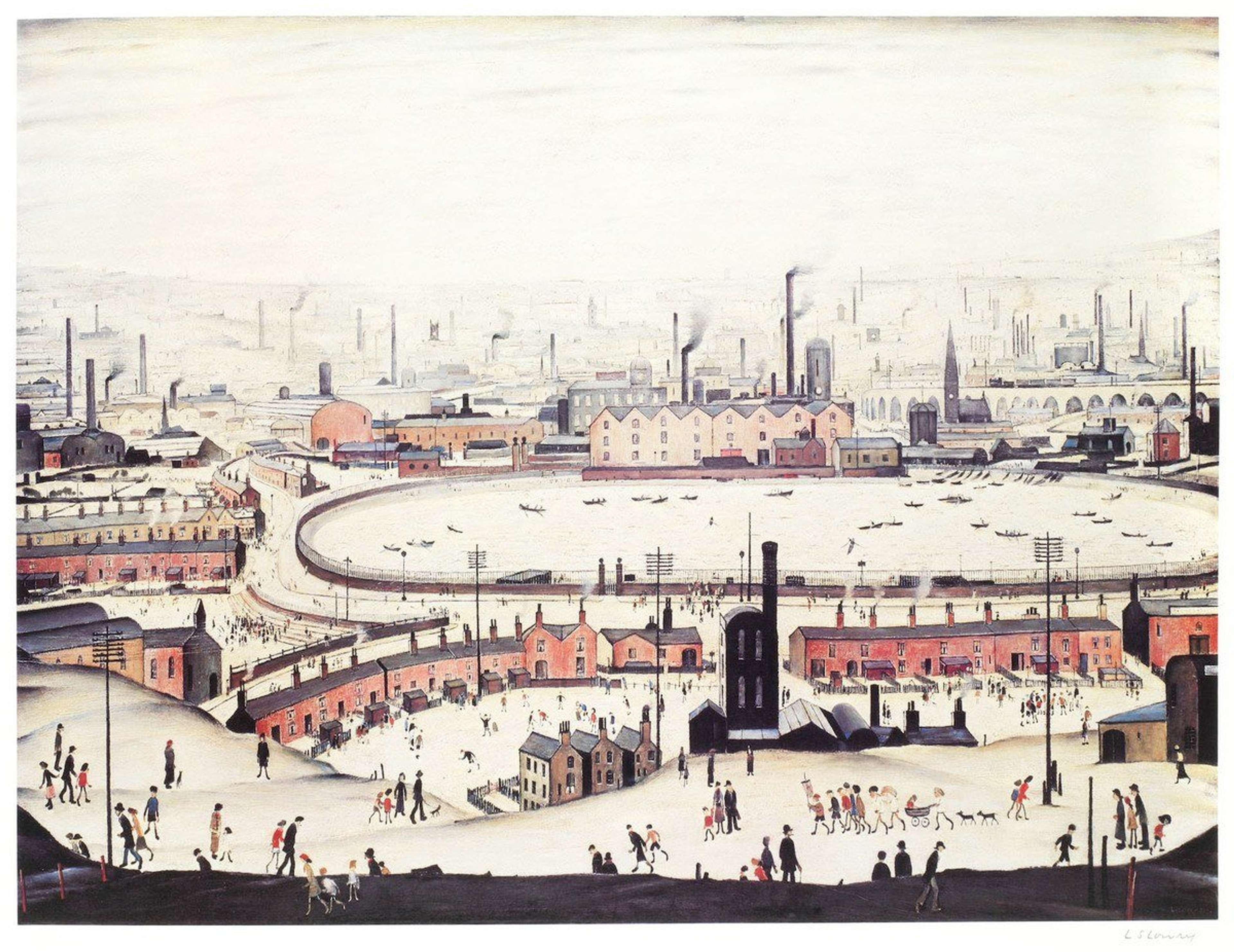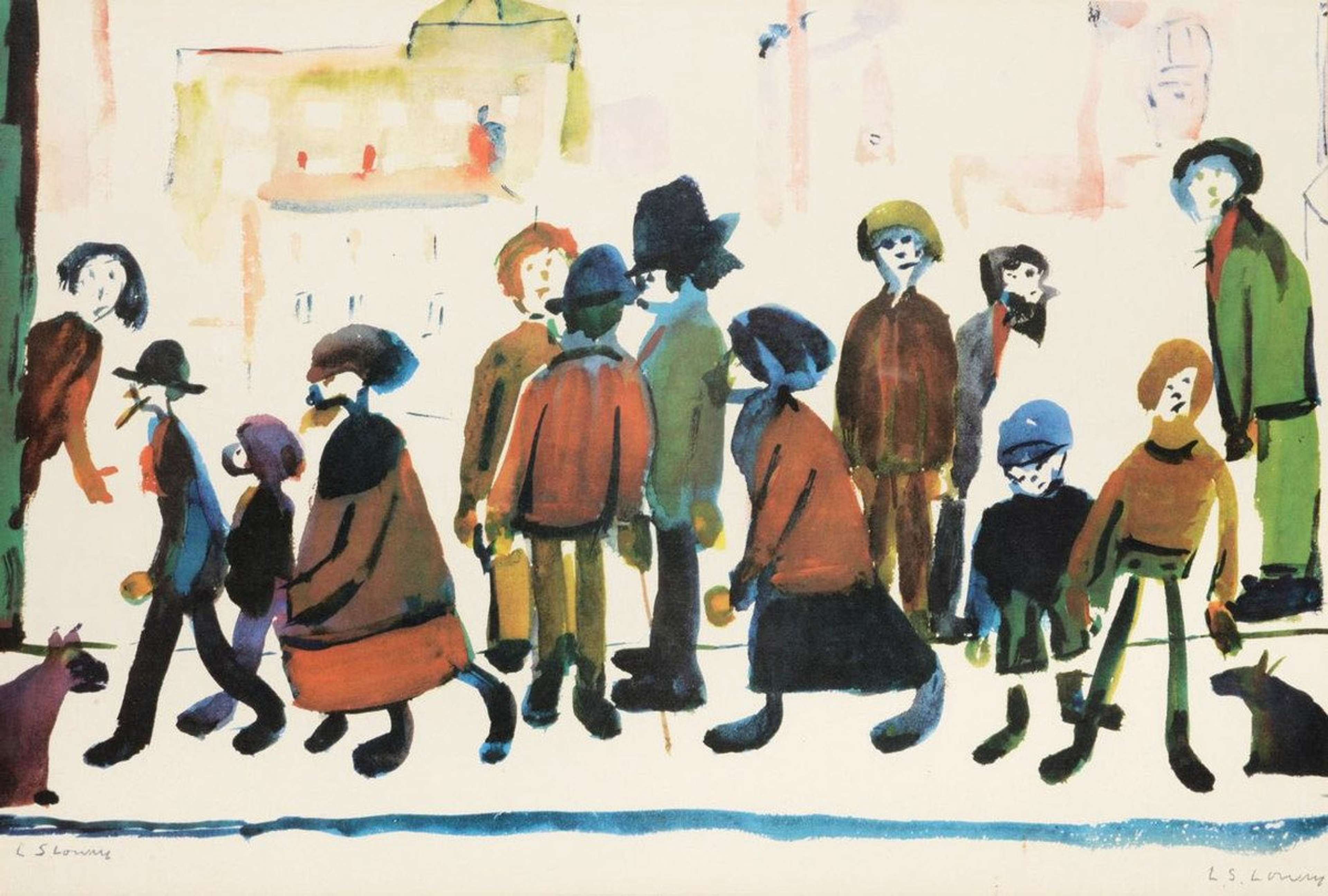 The Pond © L S Lowry 1974
The Pond © L S Lowry 1974
L S Lowry
73 works
Often mistaken as a self-taught artist during his lifetime, L S Lowry’s naïve style was actually honed from many years of art education and practice. Here we take a closer look at Lowry’s favourite materials, his artistic process and how he turned his best-known paintings into limited-edition prints.
What colours did Lowry use?
Lowry often claimed that he only used five colours. “I am a simple man. I use simple materials,” he said, “ivory black, vermilion, Prussian blue, yellow ochre, flake white.” His favourite brand of oil paint was Winsor & Newton, which he used throughout his life.
What was L S Lowry’s style?
Lowry painted in a naive, straightforward style, often using block colours and a simplified perspective. His most iconic motifs included flat, rectangular buildings; factories with tall, smoking chimneys; and “matchstick men”, or tiny, stick-thin men, women and children that crowded his cityscapes and landscapes. These figures are recognisable for their long, dowdy winter clothes, round hats and comically big shoes.
Due to the simple, childlike quality of his art, Lowry was frequently mistaken for a self-taught artist. When art critics labelled him a “Sunday painter”, he retorted, “I’m a Sunday painter every day of the week”.
Lowry was, in fact, a highly trained artist. He attended evening classes in painting and life drawing since he was 18 years old. One of his tutors was the French Impressionist painter Adolphe Valette, who introduced Lowry to the works of Claude Monet and Camille Pissarro. Like the Impressionists, Lowry had a fascination for modern urban life and street scenes. “I cannot overestimate his effect on me,” Lowry later said of Valette’s influence on his art.
What techniques did L S Lowry use?
Sketching
Lowry had an eye for observation and would obsessively sketch events happening on the street, at the beach or even at a football match. He made pencil drawings on whatever he had in his pockets, including scraps of paper, note cards and his bank statements. It is believed he produced 8,000 drawings over his lifetime.
Painting
After returning home from sketching, Lowry claimed he preferred to paint from his “mind’s eye”. He started on a white canvas – one of his evening art class tutors once said his paintings were too dark and, in response, Lowry painted on white backgrounds ever since. He first marked out the buildings and only add the people once he was satisfied with the backdrop. Lowry used his oil paints straight from the tube and sometimes even painted with his fingers to blend the oils or add texture.
On rare occasions, Lowry painted in watercolour. The artist preferred slow-drying oil paints, which gave him the flexibility to make changes, but he returned to painting in watercolours throughout his life. One example of a rare Lowry watercolour is Group of People, 1959, in the collection of The Lowry, Salford.
Prints
It is thought that Lowry signed over 35,000 limited-edition prints and lithographs during his lifetime, many of which were reproductions of his best-loved works. One of his most popular pieces, Going to the Match, saw 300 signed editions released in 1972, which remain highly sought-after in the secondary market, with top prices reaching £25,000. Notably, the original 1953 painting of Going to the Match was auctioned at Christie’s in London in 2022. With support from the Law Family charitable foundation, The Lowry acquired it for £7.8 million, significantly surpassing its 2021 valuation of £2–3 million.
By the time Lowry released his prints, many of the works were already in museum collections. The Pond, for instance, was painted in 1950 and entered the Tate’s collection in 1951. He released 850 signed editions of this artwork in 1974. The Fever Van, likewise, was first painted in 1935 and had been in the collection of Liverpool’s Walker Art Gallery since 1943; Lowry released 700 signed editions of the work in 1972.
Some prints, however, were reproductions of paintings close to Lowry’s heart and kept until his death. Sailing Boats, released in 1975 in a signed edition of 850, was one of Lowry’s first known paintings. He created the original oil painting in 1912, when he was just 25 years old, and said it was the only work that his mother ever praised him for. Lowry also reproduced three portraits of his mother, father and himself as a set of 300 signed limited-edition prints in 1975, in celebration of his 88th birthday.
Most of Lowry’s signed editions were created in runs of 300-850, with the edition number and artist’s signature marked in pencil on the paper margin below the image. The majority of Lowry’s prints also feature a “blind stamp” by the Fine Art Trade Guild, featuring a man and three letters to his right.
There are also 33 unsigned limited-edition Lowry prints on the market, which are considered significant as being overseen by Lowry during his lifetime or produced after the artist’s death with permission from his estate.
Lithographs
During the 1960s, Lowry collaborated with London’s Ganymed Press to produce 16 signed lithographers in small runs of around 75 editions. From street scenes to character studies, each artwork was a unique drawing created especially for the reproduction – as such, they are among the rarest and most sought-after of all Lowry’s prints.
The record price paid for a Lowry lithograph was for an edition of A Street Full Of People featuring unique, hand-coloured details in blue crayon – the exceptional work sold for £21,250 at Christie’s in London on 18 March 2020.
Read our L. S. Lowry Market Watch to discover Lowry's top 5 most investable prints.











